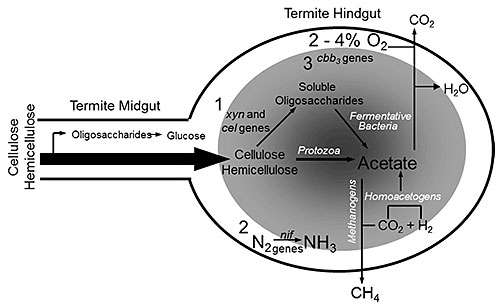Termite digestive-tract microorganisms: A resource to fuel the future

With increasing attention toward generating cost-effective biochemical conversion methods for producing biofuels, it helps to follow the leaders who have perfected the process. The mere Reticulitermes flavipes, or eastern subterranean termite, a famous feaster of lignocellulosic plant materials (e.g., decaying wood), relies on various microbial symbionts within its intestinal tract, such as Diplosphaera colotermitum TAV2 in the hindgut, to transform its carbon-rich diet into useable nutrition—its very own biofuel. However, there is a gap in understanding why TAV2, a member of the bacteria phylum Verrucomicrobia, is so at home in the seemingly inhospitable termite hindgut. Like other microbes in the termite gut, TAV2 can live in environments with much less oxygen than the 20% O2 concentration found in the atmosphere.
Scientists took aim at this trait and used comprehensive and integrative transcriptomic and proteomic approaches to identify genes and proteins being expressed by TAV2 in response to different O2 concentrations, as well as to build an experimentally tested metabolic map for TAV2 and provide a conceptual model of its functional role in the termite hindgut. This first integrated omics effort toward understanding the ecological role of a Verrucomicrobia isolate (in this case, TAV2) employed a variety of resources, including EMSL's accurate mass tag (AMT) approach, to uncover the novel ecological functions that TAV2 enables during lignocellulosic degradation within the termite gut.
Their work revealed that TAV2 can contribute to the metabolism of the termite hindgut microbial community via biological nitrogen fixation, amino-acid production, polysaccharide degradation, and O2 consumption. They also found that when TAV2 cells are maintained at hypoxic conditions, typical in parts of the termite hindgut, genes responsible for energy production and conversion, carbohydrate transport and metabolism, and replication and recombination are upregulated.
More information: Isanapong J, et al. 2013. Development of an ecophysiological model for Diplosphaera colotermitum TAV2, a termite hindgut Verrucomicrobium, The ISME Journal 7(9):1803–1813. DOI: 10.1038/ismej.2013.74.
Journal information: ISME Journal
Provided by Environmental Molecular Sciences Laboratory

















